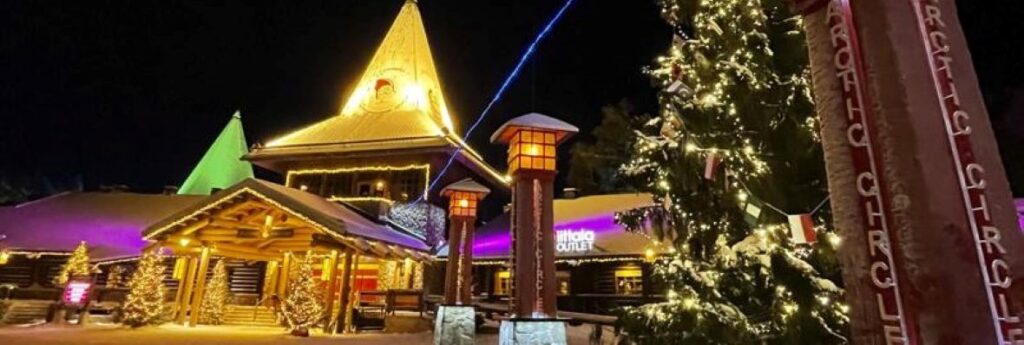The Christmas season is in full swing at Santa Claus Village in Finnish Lapland, where venue operators happily report that visitors have returned in numbers approaching pre-pandemic levels. Tourists from elsewhere in Finland and abroad come to revel in the festive spirit at the sprawling theme park, take a reindeer or husky sleigh ride, and if they’re lucky, glimpse the Northern Lights.
But how long the winter fun will at last the self-described “real North Pole” and “official residence of Santa,” located on the edge of the Arctic Circle is uncertain as the omicron coronavirus variant leads to new travel restrictions, test requirements and quarantine measures.
“It is a worry, of course, because no one knows what’s going to happen,” Sanna Karkkainen, CEO of Visit Rovaniemi, the tourism board for the capital of Finnish Lapland. “There’s always the worry that are we going to get cancellations.”
The COVID-19 pandemic and subsequent lockdowns and travel restrictions hit the northern Finnish region’s travel industry hard. Before the pandemic, about 60% of Rovaniemi’s more than half-million annual visitors came from abroad, mostly from elsewhere in Europe and some Asian countries.
According to Visit Rovaniemi, just over 11,000 people visited the city last December, an 82% drop from the same month a year earlier. Having survived a wretched 2020, many businesses see this winter as a “turning point,” Karkkainen said.
“They could not suffer another year, another Christmas, without customers, that’s for sure,” she added.
Winter is the busiest tourist season in Finnish Lapland, and Air France and Eurowings recently added new direct flights to Rovaniemi from Paris and Dusseldorf, respectively. Local businesses say demand was high this month as visitors made their way north, relieved to have gotten away after last year’s lockdowns.
“I think the last week, last few days, have been busier than ever,” Tuomas Palmgren, co-owner of Rovaniemi taxi service Santa Line, said.
Newlyweds Stefanie and Mauro Sammut decided to honeymoon in Finnish Lapland, a complete shift in temperatures from their native Malta. The couple said they feared the trip might get cancelled right up until they boarded their flight.
“Once the plane took off, we said, ‘OK, we’re fine,’” laughed Mauro Sammut, as young children slid past the couple on sleighs at Santa Claus Village and families posed for photos next to a temperature gauge that read minus 14 degrees Celsius.
SantaPark, a Lapland theme park built in an old air raid shelter, decided to close its doors in March 2020, and with the pandemic continuing to keep visitors away, only reopened this winter. The park’s chief experience officer, Ilkka Lankinen, recalled the mental distress of not knowing when they might return.
“We missed last Christmas season totally,” he said, standing in the park’s “Elf School,” where children can take a crash course on becoming one of Santa’s trusty helpers. “We tried to have the hotel open, but we also gave up on that one. So, basically, SantaPark has been closed for two years.”
There are currently no hugs with Father Christmas at Santa Claus Village — visitors are separated from Santa by a gingerbread cookie-shaped plexiglass screen. But returning tourists are a welcome sight for many, including a restaurant in central Rovaniemi that opened in August 2020.
“Most people thought we were completely crazy that we would even think about opening the restaurant in August when the situation was at its worst,” Elisa Honkavuori, the co-owner of Gustav Kitchen and Bar, said.
The restaurant’s chefs are now preparing their modern, Finnish-inspired dishes, such as rainbow trout and roasted potatoes with a caper butter sauce, to domestic and international guests. Yet Honkavuori worries the uncertainty and renewed restrictions that have arrived with the omicron variant will make people “feel that it’s not nice to travel.”
Restaurant patrons over age 16 have been required to show COVID certificates to enter Finland’s eateries since Dec. 4. For now, individuals are eligible if they can prove they are fully vaccinated against the coronavirus, present a negative test result or show they recently recovered from COVID-19.
Starting today (Dec. 21), however, Finland is reintroducing increased health screening on all travellers from outside the European Union or Europe’s 26-nation Schengen Area, requiring all arriving passengers to show proof of a negative test taken within the previous 48 hours.
For Karkkainen and her tourist board colleagues, keeping up with new rules and what they might mean for business is a daily “puzzle,” and one with no end is in sight.
“You look at the latest updates” each day and wonder, ‘What’s happening with the travellers?’” she said. “It’s been a really rough one and a half years, and the most surprising factor is that we don’t know when it’s really going to end.”

